Why is Transition Offense so Important?
In women’s volleyball, more than 50% of our offensive opportunities come in transition situations (it’s slightly less in men’s volleyball). It’s sometimes ugly and chaotic, but we need to be good in this phase of the game.
One of the ways we can get better in transition is to integrate repeatable footwork patterns that allow our athletes to turn and run, to get off the net, and to be dynamic.
What is Transition Offense?
A transition offensive attack is any attack attempt made by any player in the middle of a rally. An attack after a dig, an attack after block cover, etc, would count as a transition attack.
How much of a Volleyball Team’s Offense is in Transition?
Data from all ten West Coast Conference women’s volleyball teams in 2019 breaks down each attack attempt into the following categories:
ALL ATTACKS
- First Ball (any attack immediately following the serve-receive pass) = 47%
- Transition = 53%
IN SYSTEM ATTACKS (Attempts after a good pass/dig)
- First Ball = 54%
- Transition = 46%
OUT OF SYSTEM ATTACKS (Attempts after a bad pass/dig)
- First Ball = 36%
- Transition = 64%
These stats show us the importance of transition offense. If our attackers can be available to swing hard and get kills in these situations, our teams will score a lot of points and win a lot of matches. As front-row players improve their transition footwork, their effectiveness as a hitter will also improve.
Where Do Teams Most Often Attack From in Transition?
It’s well established that outside hitters in women’s volleyball get the most attack attempts in comparison with their teammates. Here is a breakdown of where WCC women’s volleyball teams attacked from throughout the course of the 2019 season.
ALL ATTACKS (First Ball + Transition)
- Left Side = 53%
- Middle = 16%
- Right Side (including slides) = 31%
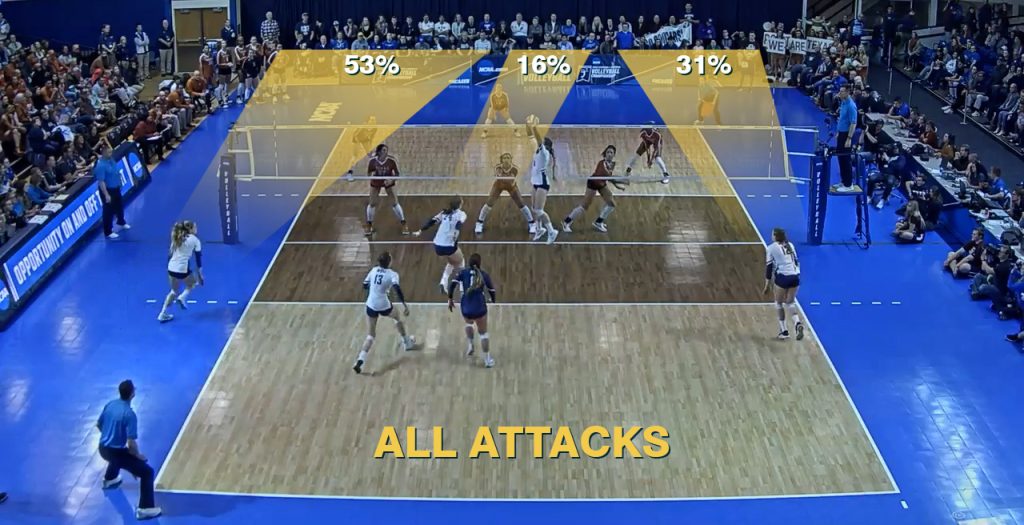
ALL TRANSITION ATTACKS
- Left Side = 58%
- Middle = 14%
- Right Side (including slides) = 28%

As much as we should want all our players to be equally involved, the unfortunate reality of transition volleyball is that our left-side attackers will get more hitting attempts than both of the other front row players combined. This realization emphasizes two important points:
- Our left side attackers must be very good in transition, especially in out-of-system situations.
- If we want our middles and opposites to be involved, they must be very good at making themselves available to our setters.
For both of these points, good transition footwork is critical. Critical for the outside hitter because she will be getting so many hitting attempts. Good footwork will help prevent fatigue, help her stay on time, and help her consistency. For the middle and opposite, because it will help them be available as an attacker, giving your setter more options and putting additional stress on opposing defenses.
How Should Hitters Get Ready in Transition?
As stated earlier, the best way for hitters to improve as transition attackers is to integrate repeatable footwork patterns that allow our athletes to turn and run, to get off the net, and to be dynamic.
There are different footwork patterns for each player to know, and they change slightly based on the following questions? Is she blocking on the left side of the court, the middle of the court, or the right side of the court? Is she defending against tips? Is she right-handed or left-handed?
LEFT SIDE ATTACKER FOOTWORK IN TRANSITION
Let’s look at three different transition footwork patterns that outside hitters will commonly use throughout the course of a volleyball match.
• Block Left + 4 Off + 4 On
After blocking to her left, the outside attacker turns into the court and takes four steps off the net, beginning with her right foot. She then takes a four-step approach before attacking.
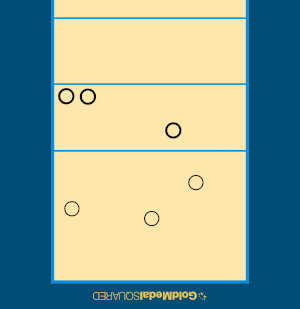
• Block Middle + 4 Off + 4 On
After blocking in the middle, the outside hitter turns to her right and takes four steps off the net, beginning with her right foot. She then takes a four-step approach before attacking.
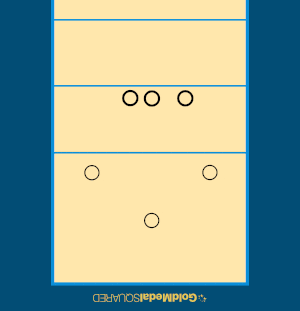
• Off Blocker Defense + 4 Off + 4 On
From her defensive 10×10 spot, the outside hitter turns to her right and takes four steps towards the sideline, beginning with her right foot. She then takes a four-step approach before attacking.
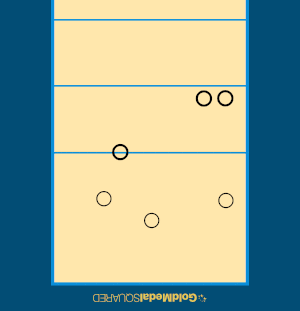
MIDDLE ATTACKER FOOTWORK IN TRANSITION
There are several different transition footwork patterns available to middle attackers, but let’s look at the three most commonly used.
• Block Left + 3 Off + 3 On
After blocking to her left, the middle attacker turns into the court and takes three steps off the net towards the three-meter line, beginning with her right foot. She then finishes her approach with a “Left-Right-Left” back towards the net.

• Block Middle + 3 Off + 3 On
After blocking in the middle, the middle attacker turns to her right and takes three steps off the net at an angle towards the three-meter line, beginning with her right foot. She then finishes her approach with a “Left-Right-Left” back towards the net.
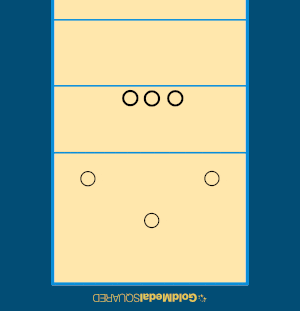
• Block Right + 3 Off + 4 On
After blocking to her right, the middle attacker turns to her left and takes three steps off the net at an angle towards the middle of the three-meter line, beginning with her left foot. She then rotates her body counter-clockwise and finishes her approach with a four-step approach back towards the net.
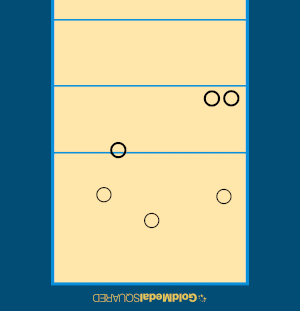
OPPOSITE FOOTWORK IN TRANSITION (RIGHT-HANDED ATTACKERS)
• Block Right + 3 Off + 4 On
After blocking to her right, the opposite turns to her left into the court and takes three steps off the net towards the three-meter line, beginning with her left foot. She then takes what we call a “negative first step”, which is a step with her right foot away from the net. This negative first step is followed by a “Left-Right-Left” back towards the net.
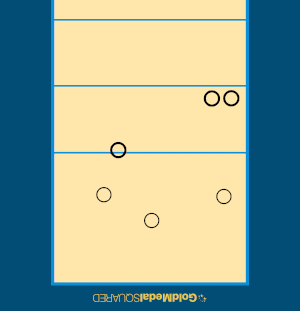
• Block Middle + 3 Off + 4 On
After blocking in the middle, the opposite turns to her left into the court and takes three steps off the net at an angle towards the sideline and the three-meter line, beginning with her left foot. Once again, she takes a negative first step with her right foot, followed by a “Left-Right-Left” back towards the net.
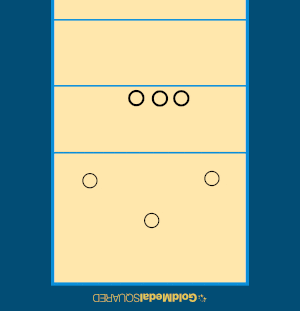
• Off Blocker Defense + 3 Off + 4 On
Similar to when she’s blocking in the middle of the court, the opposite turns to her left from her defensive spot and into the court and takes three steps at an angle towards the sideline and the three-meter line, beginning with her left foot. Once again, she takes a negative first step with her right foot, followed by a “Left-Right-Left” back towards the net.
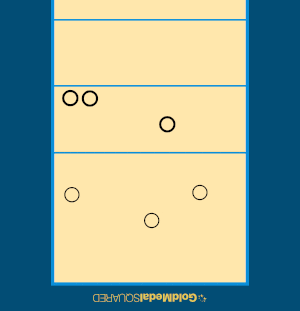
OPPOSITE FOOTWORK IN TRANSITION (LEFT-HANDED ATTACKERS)
• Block Right + 4 Off + 4 On
After blocking to her right, the opposite turns to her left into the court and takes four steps off the net towards the three-meter line, beginning with her left foot. She then takes a traditional four-step approach back towards the net before attacking.
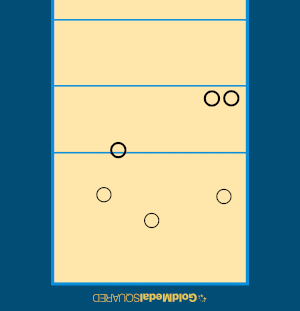
• Block Middle + 4 Off + 4 On
After blocking in the middle, the opposite turns to her left into the court and takes four steps off the net at an angle towards the sideline and the three-meter line, beginning with her left foot, followed by a traditional four-step approach.
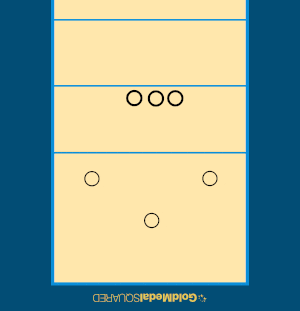
• Off Blocker Defense + 4 Off + 4 On
Similar to when she’s blocking in the middle of the court, the opposite turns to her left from her defensive spot and into the court and takes four steps at an angle towards the sideline and the three-meter line, beginning with her left foot, followed by a traditional four-step approach.

